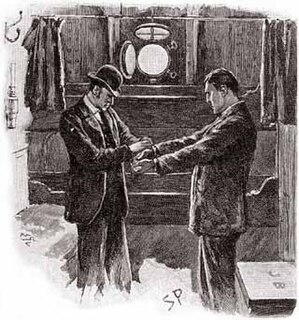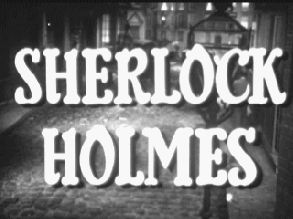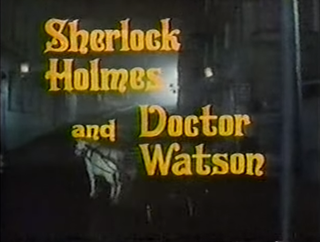Related Research Articles

Sherlock Holmes is a fictional detective created by British author Sir Arthur Conan Doyle. Referring to himself as a "consulting detective" in the stories, Holmes is known for his proficiency with observation, deduction, forensic science and logical reasoning that borders on the fantastic, which he employs when investigating cases for a wide variety of clients, including Scotland Yard.

A Study in Scarlet is a 1887 detective novel by British writer Arthur Conan Doyle. The story marks the first appearance of Sherlock Holmes and Dr. Watson, who would become the most famous detective duo in literature. The book's title derives from a speech given by Holmes, a consulting detective, to his friend and chronicler Watson on the nature of his work, in which he describes the story's murder investigation as his "study in scarlet": "There's the scarlet thread of murder running through the colourless skein of life, and our duty is to unravel it, and isolate it, and expose every inch of it."

The Adventures of Sherlock Holmes is a collection of twelve short stories by British writer Arthur Conan Doyle, first published on 14 October 1892. It contains the earliest short stories featuring the consulting detective Sherlock Holmes, which had been published in twelve monthly issues of The Strand Magazine from July 1891 to June 1892. The stories are collected in the same sequence, which is not supported by any fictional chronology. The only characters common to all twelve are Holmes and Dr. Watson and all are related in first-person narrative from Watson's point of view.

The Case-Book of Sherlock Holmes is the final set of twelve Sherlock Holmes short stories by British writer Arthur Conan Doyle first published in the Strand Magazine between October 1921 and April 1927.

His Last Bow: Some Reminiscences of Sherlock Holmes is a 1917 collection of previously published Sherlock Holmes stories by British writer Arthur Conan Doyle, including the titular short story, "His Last Bow. The War Service of Sherlock Holmes" (1917). The collection's first US edition adjusts the anthology's subtitle to Some Later Reminiscences of Sherlock Holmes. All editions contain a brief preface, by "John H. Watson, M.D.", that assures readers that as of the date of publication Holmes is long retired from his profession of detective but is still alive and well, albeit suffering from a touch of rheumatism.

Detective Inspector G. Lestrade, or Mr. Lestrade, is a fictional character appearing in several of the Sherlock Holmes stories written by Arthur Conan Doyle. Lestrade's first appearance was in the first Sherlock Holmes story, the novel A Study in Scarlet, which was published in 1887. The last story in which he appears is the short story "The Adventure of the Three Garridebs", which was first published in 1924 and was included in the last collection of Sherlock Holmes stories by Doyle, The Case-Book of Sherlock Holmes.

Sherlock Holmes is the overall title given to the series of Sherlock Holmes adaptations produced by the British television company Granada Television between 1984 and 1994. The first two series were shown under the title The Adventures of Sherlock Holmes and were followed by subsequent series with the titles of other short story collections by Sir Arthur Conan Doyle.

The Hound of the Baskervilles is a 1981 Soviet television film adaptation of Arthur Conan Doyle's 1902 novel The Hound of the Baskervilles. It was the third instalment in the TV series about adventures of Sherlock Holmes and Doctor Watson.
Sheldon Reynolds was an American television producer best known for his involvement in the Sherlock Holmes franchise.
Many writers make references to Sir Arthur Conan Doyle's famous literary creation, the detective Sherlock Holmes, and these often become embedded within popular culture. While Holmes exists predominantly in the context of Victorian-era London, he has been mentioned in such outre contexts as the 22nd century or hunting aliens or supernatural enemies. These references are in addition to the innumerable passing references to Sherlock Holmes made in many literary and cinematic works, such as the labeling of a person as a "Sherlock", whether in reference to their intelligence.

Sherlock Holmes and the Deadly Necklace is a 1962 mystery film directed by Terence Fisher. It is a West German-French-Italian international co-production. The film starred Christopher Lee as Sherlock Holmes and Thorley Walters as Dr. Watson. Curt Siodmak wrote the screenplay, based on characters created by Sir Arthur Conan Doyle.

Sherlock Holmes was a detective television series syndicated in the autumn of 1954, based on the Sherlock Holmes stories of Arthur Conan Doyle. The 39 half-hour mostly original stories were produced by Sheldon Reynolds and filmed in France by Guild Films, starring Ronald Howard as Holmes and H. Marion Crawford as Watson. Archie Duncan appeared in many episodes as Inspector Lestrade. Richard Larke, billed as Kenneth Richards, played Sgt. Wilkins in about fifteen episodes. The series' associate producer, Nicole Milinaire, was one of the first women to attain a senior production role in a television series.

The Masks of Death is a 1984 British mystery television film directed by Roy Ward Baker and starring Peter Cushing as Sherlock Holmes and John Mills as Doctor Watson.
Sherlock Holmes and Sir Arthur Conan Doyle's Sherlock Holmes are two British series of Sherlock Holmes adaptations for television produced by the BBC in 1965 and 1968 respectively. The 1965 production, which followed a pilot the year before, was the second BBC series of Sherlock Holmes adaptations, after one starring Alan Wheatley in 1951.
Silver Blaze is a 1977 British/Canadian television film directed by John Davies and starring Christopher Plummer and Thorley Walters. It is based on Arthur Conan Doyle's 1892 short story The Adventure of Silver Blaze.

The Hound of the Baskervilles is a 1921 British silent mystery film directed by Maurice Elvey and starring Eille Norwood, Catina Campbell and Rex McDougall. It is based on the 1902 Sherlock Holmes novel The Hound of the Baskervilles by Arthur Conan Doyle. It was made by Stoll Pictures, Britain's largest film company at the time. It was the first British film adaptation of the famous novel.

Sherlock Holmes and Doctor Watson is a television series created by Sheldon Reynolds and based on characters and storylines from Sir Arthur Conan Doyle's Sherlock Holmes stories. It starred Geoffrey Whitehead, Donald Pickering and Patrick Newell in the title roles of Sherlock Holmes, Doctor Watson and Inspector Lestrade respectively. The series is considered rather obscure, and was filmed on a relatively low budget in Poland. The series combined adaptations of Arthur Conan Doyle's source stories with original screenplays that saw Holmes face brand new cases.
Louis Hector was an American radio, theater, film, and television actor. He is best known for his roles of Sherlock Holmes in the 1937 broadcast of The Three Garridebs ; and that of the Reverend Browne in MGM's 1940 Technicolor release of Northwest Passage.
John Michael Drinkrow Hardwick, known as Michael Hardwick, was an English author who was best known for writing books and radio plays which featured Sir Arthur Conan Doyle's creation Sherlock Holmes. He adapted most of the episodes of the Sherlock Holmes BBC radio series 1952–1969.
Sherlock Holmes is a French-British silent film series consisting of eight short films which were produced in 1912 by Éclair.
References
- 1 2 Davies, David Stuart (2007). Starring Sherlock Holmes. Titan Books. p. 134. ISBN 978-1845765378.
- 1 2 3 4 5 6 7 8 Barnes, Alan (2011). Sherlock Holmes on Screen. Titan Books. pp. 190–191. ISBN 9780857687760.